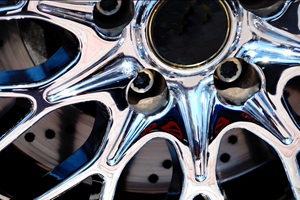U.S. EPA Tightens Chromium Air Standards for Coatings
NASF Highlights Weak Rationale to White House
EPA Administrator Lisa Jackson recently signed a final rule that tightens air emission standards for chromium electroplating and anodizing operations (download a copy at NASF.org). The regulation, which was finalized to meet an August 15, 2012 court-ordered deadline, imposes new stringent air emission limits, lower surface tension levels, new housekeeping practices, and a ban of PFOS-based fume suppressants.
EPA wrote the tougher standard under the federal NESHAP (National Emission Standard for Hazardous Air Pollutants) program even though the agency had concluded that the current health risk associated with U.S. chromium finishing operations is acceptable. NASF reminded EPA at a meeting with the White House that the agency provided no credible evidence to support the revised limits. NASF has prepared a brief summary of the rule below for this month’s NASF Report. For more detailed information, please contact Jeff Hannapel at jhannapel@ thepolicygroup.com or (202) 257-3756.
EPA’s New Chromium Air Emission Requirements:
Lower Surface Tension Levels
The rule lowers the required surface tension levels from 35 dynes to 33 when measuring with a tensiometer and from 45 dynes to 40 when measuring with a stalagmometer. NASF does not view this change as a significant revision to the current requirement.
Lower Emission Limits
However, EPA has tightened emissions limits to the lowest in the world for both existing and new decorative chromium plating, chromic acid anodizing, and hard chromium plating processes. EPA reduced the emissions limits by a range of 25 to 50 percent for existing sources, and all new sources must comply with a new limit of 0.006 mg/dscm, which is 40 to 60 percent lower than the previous limits. Please see the table of changes below:
Demonstrating Compliance with Emission Limits
Facilities must demonstrate compliance with the new limits by conducting a performance or stack test. Facilities may use a previous performance test to demonstrate compliance with the new emission limits, provided that:
- the test was conducted after January 25, 1995,
- the source is using the same emission controls that were used during the compliance test,
- the source was operating under conditions that are representative of the conditions under which the source was operating during the compliance test, and
- the test was based on approval from a permitting authority.
Housekeeping Practices
Companies must implement the following housekeeping practices designed to minimize chromium emissions, in line with California’s current requirements:
- substances that include hexavalent chromium must be stored in closed containers,
- take measures to minimize spills of bath solutions,
- install splash guards for spraying operations,
- cleanup or contain spills within one hour of the spill,
- clean surface with HEPA vacuuming, hand-wiping, wet mopping, or hosing down and collecting in wastewater collection system,
- separate buffing, grinding and polishing operations from electroplating and anodizing processes with a physical barrier, and
- take measures to minimize fugitive dust emissions.
PFOS-based Fume Suppressants Ban
The regulation bans the use of fume suppressants that contain one percent or greater of PFOS by weight.
Effective Dates
The final regulation is effective upon the date of publication in the Federal Register (not published at press time. Facilities must comply with the following provisions of the new standard by the following dates: housekeeping practices—within 60 days of the date of publication in the Federal Register; surface tension levels—within 2 years of the date of publication in the Federal Register; emission limits—within 2 years of the date of publication in the Federal Register; ban of PFOS fume suppressants—within 3 years of the date of publication in the Federal Register
Process for Challenging the Final Rule
The NASF is considering a legal challenge to the final rule. Petitions for judicial review of the final rule must be submitted to the U.S. Court of Appeals within 60 days of the date of publication in the Federal Register. The process can take up to a year or more to complete.
In addition, NASF may have an option to submit a petition for reconsideration of the rule to EPA. Pursuing such an option may depend on the Agency’s willingness to entertain such a reconsideration of the rule. Accordingly, NASF will be evaluating its options for challenging the final rule and possible settlement opportunities.
NASF will continue to review and evaluate the industry impacts of final rule. For any questions or additional information on the revised standard, please contact Jeff Hannapel at jhannapel@thepolicygroup.com or 202-257-3756.
National Association for Surface Finishing
Related Content
Successful South African Plater Beating the Odds
Remaining focused on quality and reliability, Team Plating Works stays profitable in a volatile and challenging economy.
Read MoreHow to Maximize Nickel Plating Performance
The advantages of boric acid-free nickel plating include allowing manufacturers who utilize nickel plating to keep up the ever-changing regulatory policies and support sustainability efforts.
Read MoreProducts Finishing Reveals 2024 Qualifying Top Shops
PF reveals the qualifying shops in its annual Top Shops Benchmarking Survey — a program designed to offer shops insights into their overall performance in the industry.
Read MoreA Chromium Plating Overview
An overview of decorative and hard chromium electroplating processes.
Read MoreRead Next
Education Bringing Cleaning to Machining
Debuting new speakers and cleaning technology content during this half-day workshop co-located with IMTS 2024.
Read MoreEpisode 45: An Interview with Chandler Mancuso, MacDermid Envio Solutions
Chandler Mancuso, technical director with MacDermid Envio discusses updating your wastewater treatment system and implementing materials recycling solutions to increase efficiencies, control costs and reduce environmental impact.
Read MoreDelivering Increased Benefits to Greenhouse Films
Baystar's Borstar technology is helping customers deliver better, more reliable production methods to greenhouse agriculture.
Read More








.jpg;maxWidth=300;quality=90)












